Abstract
The Food and Agricultural Organization of the United Nations (FAO) Penman–Monteith (PM) method is widely regarded as the most effective reference evapotranspiration (ETo) estimator; however, it requires a wide range of data that may be scarce in some rural regions. When feasible relative humidity, solar radiation and wind speed data are unavailable, a temperature-based method may be useful to estimate ETo and provide suitable data to support irrigation management. This study has evaluated the accuracy of two ETo estimations methods: (1) a locally and monthly adjusted Hargreaves–Samani (HS) equation; (2) a simple procedure that only uses maximum temperature and a temperature adjustment coefficient (MaxTET). Results show that, if a monthly adjusted radiation adjustment coefficient (kRs) is calibrated for each site, acceptable ETo estimations (RMSE and R2 equal to 0.79 for the entire region) can be achieved. Results also show that a procedure to estimate ETo based only on maximum temperature performs acceptably, when compared with ETo estimation using PM equation (RMSE = 0.83 mm day−1 and R2 = 0.77 for Alentejo). When comparing these results with the ones attained when adopting a monthly adjusted HS method, the MaxTET procedure proves to be an accurate ETo estimator. Results also show that both methods can be used to estimate ETo when weather data are scarce.
1. Introduction
The Food and Agricultural Organization of the United Nations (FAO) Penman–Monteith (PM) reference evapotranspiration (ETo) equation [1], despite being regarded as the most accurate method to estimate ETo, is not always viable since data quality needs to be assured and representative of well-watered conditions [2]. Despite its wide adoption in many regions and climates [3,4], the data required may not be easily available in some rural areas where full weather stations may not exist or, if available, the data collected may be of poor quality. The PM calculation requires air temperature, windspeed, relative humidity and solar radiation. While maximum (Tmax) and minimum (Tmin) temperature data are commonly observed at most weather stations, windspeed (u2), relative humidity (RH) and solar radiation (Rs) are not frequently available, and, if recorded, the data quality may not be adequate. To overcome this constraint, [1] proposed a set of methods that allow for the estimation of theses missing variables. When RH data are missing, [1] recommended the estimation of actual vapor pressure based on the assumption that minimum temperature could be an acceptable estimator of dew point temperature. For estimation of Rs, [1] proposed the adoption of the Hargreaves–Samani method [5], which expresses Rs as a linear function expressed as:
where kRs is an empirical radiation adjustment coefficient (°C−0.5) and Ra is the extraterrestrial radiation (MJ m2 day−1). Allen et al. [1] also proposed the use of the world average wind speed value u2 = 2 m s−1 as the default estimator when wind speed data are missing. However, this estimation may lead to some accuracy error [6,7].
Rs = kRs × Ra × (Tmax − Tmin)0.5
Droogers and Allen [8] concluded that if accurate weather data collection can be expected, the PM equation is advisable but, otherwise, a modified Hargreaves–Samani equation should be considered. The latter focuses only on maximum and minimum temperatures and, if locally calibrated, can lead to accurate ETo estimations [9]. Given its simplicity, this model can be applied, as it depends only on temperature, and most weather stations collect these data [8]. Other temperature-based methods to estimate ETo are available in the literature [8,10,11,12,13]. Rodrigues and Braga [14] compared nine different temperature-based methods in order to determine the best model based on the weather conditions of fourteen locations in Alentejo, Southern Portugal. They have shown that, after calibrating the kRs for a specific location, the Hargreaves–Samani (HS) method showed its appropriateness for the most of part for the locations, leading to acceptable ETo estimations (RMSE = 0.84 mm day−1). However, it would benefit from further calibration, where a monthly kRs could be obtained. Nonetheless, the calculation of extra-terrestrial radiation can be a limitation for some users, and the complexity of calculation of both PM and HS methods requires a computerized approach to ease ETo estimation.
State and federal agency personnel, as well as farmers, as the final and main beneficiaries of direct methods, and their advisors would take advantage of a simpler method in terms of required data and calculation. Moreover, if we consider using meteorological forecast data rather than using historical data. An early attempt was made by [15] where potential evapotranspiration from areas of natural vegetation was determined from average temperature records alone. Despite the apparent simplicity, the method requires a complex mathematical computation to estimate ETo. A more recent approach, developed by [16] in Ethiopia, aimed to develop a simpler method. The advantage of this method is that it uses only maximum temperature to estimate ETo for a specific location. However, the method requires the calibration of a site-specific factor, dependent on average temperature. Still, when assessing its accuracy for the Alentejo region, [14] concluded that this method lacks a scaling capability since it led to an RMSE varying from 2.22 to 4.00 mm day−1 when estimating ETo for fourteen locations across the region.
The main objective of this study was to develop and validate a new simple temperature-based procedure that uses only maximum temperature for areas where other climatic parameters may not be available during the irrigation season and where its use is expeditious. This will allow the end users, due to the procedure’s simplicity, to easily estimate ETo not only from historical data, but also to forecast ETo based on estimated maximum temperature. The main purpose is to not to create a new standard equation, but a procedure that allows the establishment of a strict relation between maximum temperature and ETo. Simultaneously, the radiation adjustment coefficient (kRs) will be calibrated for each location in order to assess if it leads to improved ETo estimations. Finally, the performance of the new simple temperature-based procedure, in comparison with the PM or HS method, will be assessed.
2. Materials and Methods
2.1. Study Area
This study was conducted in the Alentejo region, Southern Portugal. Meteorological data were collected by the weather stations network (SAGRA—http://www.cotr.pt/servicos/sagranet.php) installed at 14 locations managed by the Irrigation Operation and Technology Center (COTR). Each station collects data on maximum and minimum air temperatures, relative humidity, wind speed, rainfall and solar radiation. All data are validated daily by a team of experienced technicians, assuring quality and feasibility.
Figure 1 and Table 1 present, respectively, the geographical position of the locations evaluated, and their coordinates, period of data and mean and standard deviation for maximum and minimum temperatures, PM reference evapotranspiration and rainfall during the irrigation season. The region, according to Köppen–Geiger classification, has a Csa climate, and is characterized by a semiarid Mediterranean climate of hot and dry season in the summer and mild temperature associated with annual rainfall in winter. A more comprehensive characterization of the study is presented by [14]. This study was conducted from April to October, the period that covers the growing season of the main crops in Alentejo, where irrigation is essential to maintain crop yields and profitability.
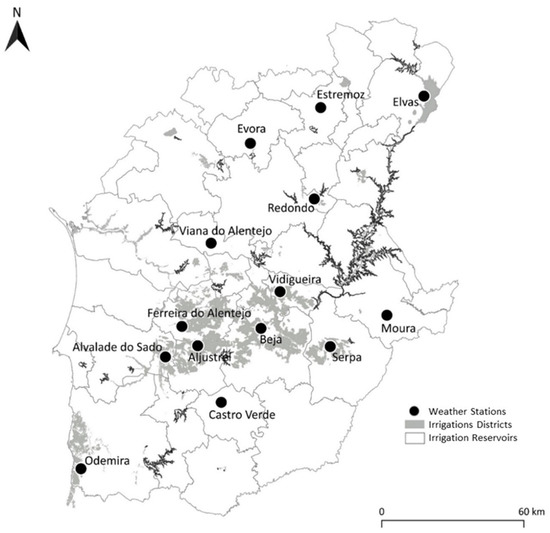
Figure 1.
Weather station locations, Alentejo, Southern Portugal.

Table 1.
Weather stations characterization, data range of the weather data series and annual means and standard deviations of maximum (Tmax) and minimum (Tmin) temperatures, reference evapotranspiration (ETo) and mean annual rainfall.
2.2. Evapotranspiration Estimation Methods
For this research, three different methods were adopted to estimate refence evapotranspiration.
(a) FAO-56 Penman–Monteith (PM):
The method, as proposed by [1], is expressed by:
where ETPM is the grass reference evapotranspiration (mm day−1); Rn is the net radiation (MJ m−2 day−1); G is the soil heat flux density (MJ m−2 day−1), considered as null for daily estimates; T is the daily mean air temperature (°C) at 2 m, based on the average of maximum and minimum temperatures; u2 is the average wind speed at 2 m height (m s−1); es is the saturation vapor pressure (kPa); ea is the actual vapor pressure (kPa); (es − ea) is the saturation vapor pressure deficit (Δe, kPa) at temperature T; Δ is the slope of the saturated vapor pressure curve (kPa °C−1); γ is the psychrometric constant (0.0677 kPa °C−1). As for this study, the computation of all data required for calculating ETo were performed following [1].
(b) Hargreaves–Samani (HS):
The Hargreaves–Samani method [5] estimates ETo using only the observed maximum and minimum temperatures and the estimation of the extraterrestrial radiation base, and is expressed by:
where ETHS is the grass reference evapotranspiration (mm day−1); Ra is the extraterrestrial radiation (MJ m−2 day−1), 0.0135 is a factor for conversion from American to the International system of units; Tavg is the average air temperature (°C); Tmax is the maximum air temperature (°C); Tmin is the minimum air temperature (°C) and kRs is the radiation adjustment coefficient (°C−0.5). The empirical coefficient kRs was originally considered [5] as 0.17 °C−0.5. For this study, a monthly kRs was locally calibrated.
ETHS = 0.0135 × kRs × 0.408Ra × (Tavg + 17.8) × (Tmax − Tmin)0.5
(c) Single temperature procedure (MaxTET):
In this study, the PM method was used as the standard method for the development of a new simple temperature method that uses only maximum temperature for the estimation of ETo. A standard equation is hereby proposed as a maximum temperature-based evapotranspiration (MaxTET) procedure to estimate ETo:
where ETTmax is the reference crop evapotranspiration (mm day−1), kTmax is the temperature adjustment coefficient (mm °C−1) and Tmax is the maximum air temperature (°C). For this purpose, a monthly kTmax was locally calibrated.
2.3. Evaluation Criteria
The accuracy of the ETo estimations was assessed through the indicators listed below, where ETPMi and ETTBi (i = 1, 2, …, n) represent pairs of values of ETo estimated using the PM method and another temperature-based model, respectively, for a given variable and and are the respective mean values:
- The coefficients of regression and determination relating observed and simulated data, b and R2, respectively, are defined as:
- The root mean square error, RMSE, which characterizes the variance of the estimation error:
In order to improve the accuracy of ETo estimations, these indicators were used to determine both kRs and kTmax. The calibration of these coefficients was performed using a trial and error procedure for each month and location, was calibrated using 50% of the years, randomly chosen from the dataset, and validated for the remainder of the years. Results for both HS and MaxTET approaches were compared with the PM method to test its accuracy.
3. Results
3.1. Estimating a Monthly Adjusted Radiation Adjustment Coefficient for Each Location
Table 2 shows the validated kRs for each month and location, as well as the irrigation season calibrated factor as suggested by [14]. Results show that, for most locations, the monthly calibrated kRs differ, both locally and monthly, from the seasonal coefficient as proposed by [14]. Locations with the same seasonal coefficient, such as Beja, Castro Verde, Odemira and Redondo (seasonal kRs = 0.17), tend to have different validated monthly kRs throughout the irrigation season. kRs for Beja varies from 0.16 to 0.18, while for Castro Verde and Redondo the empirical coefficient varies from 0.16 to 0.19. Additionally, when comparing the validated kRs between those locations for the same month, different values may be found. For the month of July, the empirical radiation coefficient equals 0.17, 0.18, 0.16 and 0.17 for Beja, Castro Verde, Odemira and Redondo, respectively; but, for the month of October, a kRs of 0.18, 0.19, 0.17 and 0.19 was obtained the same locations. For the entire Alentejo region, the coefficient ranges 0.15–0.16. Results also show that there is no regularity in the variation of kRs values throughout the season.

Table 2.
Validated Hargreaves–Samani radiation adjustment coefficient (kRs) values for each month and location.
Figure 2 reports the effect of the distance to the sea over kRs. Results demonstrate that, contrarily to what is proposed by [1], the kRs does not decrease with further distance to the sea. From the analysis in Figure 2, it can be concluded that “coastal” locations (such as Odemira an Alvalade do Sado) tend to reveal a lower kRs than some more “interior” sites. However, there is no clear trend; locations with similar distances to the sea (e.g., Moura and Redondo) show quite different values. For Moura, the kRs ranges from 0.13 to 0.14, while for Redondo the adjustment coefficient varies from 0.17 to 0.19. Indeed, the validated values for the latter are even higher than the ones obtained for more “coastal” locations, contradicting the standard trend as proposed by [1]. These results show there is no clear relation with the distance to sea, suggesting that other factors such as latitude, altitude and closeness to irrigated fields may have a direct impact on the radiation adjustment coefficient.
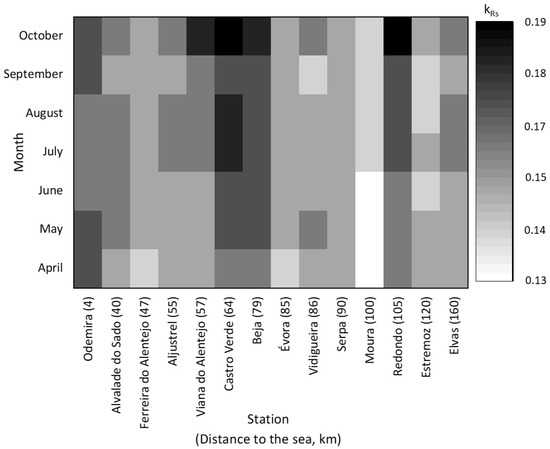
Figure 2.
Validated Hargreaves–Samani radiation adjustment coefficient (kRs) values for each month and location ordered according to the distance to the sea (km).
Table 3 shows the statistical summary (b, R2, RMSE) of ETo estimates for each location, which resulted from adopting the monthly adjusted HS method for calibration, validation and all years. As a comparison, Table 3 also presents the accuracy of the ETo estimations when using a seasonal calibrated kRs for each site, as proposed by [14]. Results show that, after monthly calibrating the kRs factor, ETo estimations by the HS equation tend to improve the method’s accuracy. For 10 locations (Aljustrel, Beja, Castro Verde, Elvas, Estremoz, Ferreira do Alentejo, Moura, Odemira, Redondo and Viana do Alentejo) the RMSE decreased, on average, from 0.77 to 0.74 mm day−1, while the R2 increased from 0.79 to 0.80. As for the remaining four locations (Alvalade do Sado, Évora, Serpa and Vidigueira), the statistical results remain similar. For the entire Alentejo region, results also demonstrate an improvement, with the RMSE decreasing from 0.84 to 0.79 mm day−1 and the coefficient of determination increasing from 0.77 to 0.79, proving that a monthly calibrated coefficient leads to improved ETo estimations. This trend come into agreement with the results found by [17], where the accuracy of ETo estimations when moving from an annual to seasonal calibration tends to improve significantly (especially from spring and summer).

Table 3.
Accuracy of ETo estimations using the Hargreaves–Samani (HS) method after a monthly radiation adjustment coefficient (kRs) factor calibration/validation.
3.2. Validation of a Maximum Temperature-Based ETo Estimation Procedure
The proposed approach (Equation (4)) to develop maximum temperature-based ETo estimation procedure (MaxTET) requires the determination of a temperature conversion coefficient (kTmax). Table 4 presents the validated kTmax for each month and location.

Table 4.
Validated temperature adjustment coefficient (kTmax) values for each month and location.
Table 5 presents the statistical summary (b, R2, RMSE) of ETo estimates for each location, which resulted from adopting the MaxTET procedure, for calibration, validation and all years. Results show that this method predict ETo with acceptable accuracy, with R2 higher than 0.75 for most locations; only Odemira shows a slightly lower coefficient of determination (R2 = 0.65). Additionally, this method led to an RMSE lower than 0.91 mm day−1 (as low as 0.65 mm day−1 for Odemira), averaging 0.80 mm day−1, with slight to no under- or overestimation of the ETo for all locations (b varied from 0.98 to 1.01). These results agree with the ones found by [8] when estimating ETo from a modified HS equation, leading to an RMSE = 0.72 mm day−1. Even when upscaling the approach for the entire Alentejo region, the MaxTET method proved to be accurate for ETo estimations, with a slope of 0.98, an R2 equal to 0.77 and an RMSE of 0.83 mm day−1. Results for calibration and validation datasets tend to be similar, with low variations for both R2 and RMSE indicators.

Table 5.
Accuracy of ETo estimations using the maximum temperature-based evapotranspiration (MaxTET) procedure after temperature adjustment coefficient (kTmax) calibration/validation.
3.3. Comparing the Accuracy of MaxTET and Monthly Adjusted Hargreaves–Samani Methods
To better assess the accuracy of relationships, ETHS/ETTmax and ETPM regression lines were used (Figure 3). Generally, both methods performed well in the study area. Results demonstrate that, for all locations, both Hargreaves–Samani and MaxTET tend to overestimate low ETo values, while for high ETo values both methods tend to underestimate reference evapotranspiration. For Aljustrel, Castro Verde, Évora, Redondo and Vidigueira, both methods led to similar results for high ETo values. Globally, both methods seem to accurately estimate the ETo for all 14 locations and for the Alentejo region as a whole.
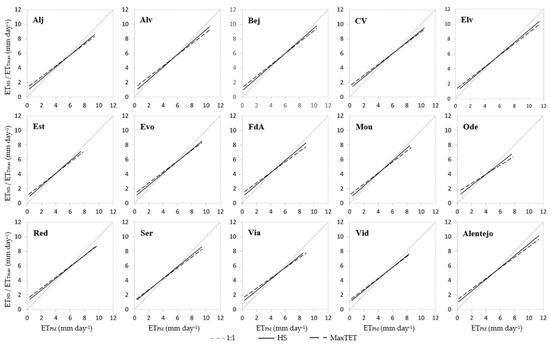
Figure 3.
Comparison of monthly adjusted Hargreaves–Samani (HS) method and maximum temperature-based evapotranspiration (MaxTET) procedure with Penman–Monteith (PM) for all locations.
Figure 4 presents a comparison of the accuracy when estimating ETo, for each location, using the MaxTET, and the monthly and seasonally adjusted HS methods. Results show that for, for all 14 locations, the RMSEs for the three methods are similar. Despite of leading to a higher RMSE, in comparison with the monthly adjusted HS method, the MaxTET procedure led to differences that varied from 0.02 (for Moura and Odemira) to 0.10 mm day−1 (for Castro Verde), averaging an RMSE equal to 0.05 mm day−1. Similarly, when comparing to the seasonally adjusted HS method, the MaxTET procedure led to a higher RMSE by, on average, 0.03 mm day−1. Contrarily, for the entire Alentejo region, the MaxTET procedure proved to be more accurate than the seasonally adjusted HS method, resulting in a lower RMSE (0.83 and 0.84 mm day−1, respectively).
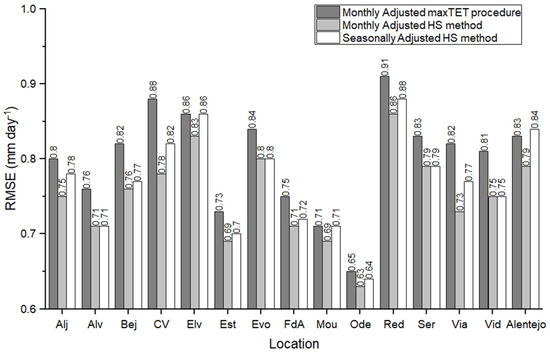
Figure 4.
RMSE (mm day−1) of ETo estimations using the maximum temperature-based evapotranspiration (MaxTET) procedure, and monthly and seasonally adjusted Hargreaves–Samani (HS) methods.
Figure 5 shows the spatial distribution of RMSE of ETo estimations using the MaxTET and monthly adjusted HS methods showing a trend for lower values on “coastal” locations and higher values for more “interior” sites. Estremoz, Odemira and Moura tended to show a lower RMSE for both methods. These locations also tend to have lower ETo values (Table 1), thus lower RMSEs would be expected. Contrarily, Castro Verde, Elvas and Redondo, locations where ETo tends to be high (>5 mm day−1), present higher RMSE values. Globally, for all locations, the RMSE represents around 17% and 16% of the average ETo for MaxTET and monthly adjusted HS methods, respectively. One can conclude that both models perform similarly across the region.
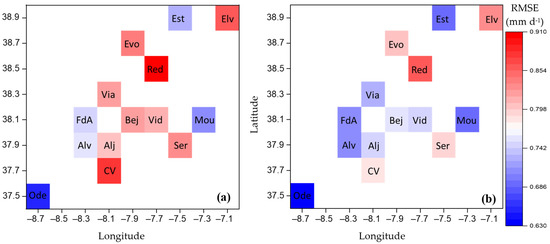
Figure 5.
Spatial distribution of RMSE (mm day−1) of ETo estimations using (a) the maximum temperature-based evapotranspiration (MaxTET) procedure and (b) monthly adjusted Hargreaves–Samani (HS) method for all 14 locations.
4. Discussion
According to [1], the empirical coefficient kRs ranges from 0.16 to 0.19 °C−0.5, respectively, for “interior” or “coastal” regions, diverging from the original coefficient proposed by [5], with kRs = 0.17 °C−0.5. Nevertheless, kRs is supposed to vary with altitude, reflecting the air pressure changes as for the volumetric heat capacity of the atmosphere [18], and should vary spatially, internalizing the effects of the site elevation and distance to sea [1]. Allen [18] also found that, for some specific locations, kRs may vary seasonally. Thus, one can suggest that not only a local calibration but also a monthly adjustment should be performed to reflect the volumetric heat capacity of the atmosphere.
Results presented in Table 3 show that using just one kRs per location may lead to less accurate ETo estimations. Results also show that a trend can be found across the irrigation season. For some locations, such as for Redondo and Viana do Alentejo, the radiation adjustment coefficient tended to increase during the irrigation season. Contrarily, some regions, such as Évora and Ferreira do Alentejo, remain mostly the same during the same period. Results (Figure 2) also demonstrate that, contrarily to what is proposed by Allen et al. (1998), the kRs does not decrease with further distance to the sea. For summer months, “interior” and “coastal” locations illustrate the same radiation adjustment coefficient, reinforcing the statement that one should not assume the standard values of 0.16 and 0.19 °C−0.5, respectively, for “interior” or “coastal” regions. This can be due to the fact that, during these peak months, most cropped fields are being irrigated, influencing the air moisture and impacting the volumetric heat capacity of the atmosphere. It can be concluded that a monthly calibration/validation is advisable since kRs can vary, not only depending on the distance to the sea, but also according to the month for which ETo is being estimated.
Based on the fact that to improve ETo estimation a local calibration of adjustment factors is strongly recommended, one could ask: can a simpler equation be developed to provide farmers with a method with low need of calculations and data, while still maintaining an accurate estimation of ETo? To answer this question, the MaxTET was tested. The procedure proved to be accurate for ETo estimations, with an R2 equal to 0.77 and an RMSE of 0.83 mm day−1 for the entire Alentejo region. Enku and Melesse [16] aimed to develop a temperature-based evapotranspiration method for Ethiopia and, although more complex than the one proposed here, led to similar accuracy results, with an average R2 equal to 0.65 and an RMSE averaging 0.59 mm day−1. However, and according to [14], the accuracy of this method, when estimating ETo for Alentejo, does not support its adoption since it led to an RMSE higher than 2.20 m day−1; one can conclude that the MaxTET procedure outperforms the previous established method proposed by [16] since it led to more accurate estimation results.
Accuracy results (Figure 4) indicated the appropriateness of using both the MaxTET and monthly adjusted Hargreaves–Samani methods for all the locations, since they led to acceptable ETo estimations when only temperature data were available. Additionally, and based on these results, due to its simplicity (using a maximum temperature adjustment factor), the MaxTET procedure proved to be an alternative estimator of ETo to HS for all 14 locations, providing very similar results.
5. Conclusions
In some rural areas, weather data availability may be scarce. Despite being regarded as most effective reference evapotranspiration (ETo) estimator, the FAO Penman–Monteith (PM) method requires a wide range of data that may be not be available or even feasible. For these cases, a temperature-based method may be useful to estimate ETo and provide suitable data to support irrigation management. Farmers would benefit from simpler methods in terms of required data and calculation, since time and data are scarce in their daily activities. This study has evaluated the accuracy of two ETo estimations methods: (1) a locally and monthly adjusted Hargreaves–Samani (HS) equation; (2) a simple procedure that only that uses maximum temperature and a temperature adjustment coefficient.
Results show that, instead of using only one calibrated radiation adjustment coefficient (kRs) per location, if a monthly adjusted kRs is calibrated for each site, it leads to improved ETo estimations. Results also showed that there is no clear effect of the distance to the sea over kRs, reinforcing the statement that one should not assume the standard values available in the literature. Additionally, results show that a monthly calibration/validation is advisable since kRs can vary not only depending on the distance to the sea, but also according to the month for which ETo is being estimated.
Results also show that a procedure to estimate ETo based only on maximum temperature (MaxTET) performs acceptably, compared with an ETo estimation using a PM equation, with similar results for both calibration and validation datasets. When comparing these results with the ones achieved when adopting a monthly adjusted HS method, and despite leading to a slightly lower accuracy, the MaxTET procedure proved to be an accurate ETo estimator indicating the appropriateness of using this simple approach.
In conclusion, this simpler procedure to estimate could be used for the estimation of ETo where data are insufficient or of poor quality.
Author Contributions
Conceptualization, G.C.R. and R.P.B.; methodology, G.C.R. and R.P.B.; Data analysis, G.C.R.; writing–original draft preparation, G.C.R.; writing–review and editing, G.C.R. and R.P.B. Both author have read and agreed to the published version of the manuscript.
Funding
This research was funded by FCT through the research unit LEAF (UID/AGR/04129/2020).
Institutional Review Board Statement
Not applicable.
Informed Consent Statement
Not applicable.
Data Availability Statement
Weather data was obtained from COTR and are available at http://www.cotr.pt/servicos/sagranet.php with the permission of COTR.
Acknowledgments
Authors thanks COTR—Irrigation Operation and Technology Center for the data provided for this study.
Conflicts of Interest
The authors declare no conflict of interest.
References
- Allen, R.G.; Pereira, L.S.; Raes, D.; Smith, M. Crop Evapotranspiration: Guidelines for Computing Crop Water Requirements; Irrigation and Drainage Paper 56; FAO: Rome, Italy, 1998; 300p. [Google Scholar]
- Pereira, L.S.; Allen, R.G.; Smith, M.J.; Raes, D. Crop evapotranspiration estimation with FAO56: Past and future. Agric. Water Manag. 2015, 147, 4–20. [Google Scholar] [CrossRef]
- Allen, R.G.; Clemmens, A.J.; Burt, C.M.; Solomon, K.; O’Halloran, T. Prediction accuracy for pro-ject wide evapotranspiration using crop coefficients and reference evapotranspiration. J. Irrig.Drain. Eng. 2005, 131, 24–36. [Google Scholar] [CrossRef]
- Allen, R.; Pruitt, W.O.; Wright, J.L.; Howell, T.A.; Ventura, F.; Snyder, R.; Itenfisu, D.; Steduto, P.; Berengena, J.; Yrisarry, J.B.; et al. A recommendation on standardized surface resistance for hourly calculation of reference ETo by the FAO56 Penman-Monteith method. Agric. Water Manag. 2006, 81, 1–22. [Google Scholar] [CrossRef]
- Hargreaves, G.H.; Samani, Z.A. Reference Crop Evapotranspiration from Temperature. Appl. Eng. Agric. 1985, 1, 96–99. [Google Scholar] [CrossRef]
- Jabloun, M.D.; Sahli, A. Evaluation of FAO-56 methodology for estimating reference evapotranspiration using limited climatic data: Application to Tunisia. Agric. Water Manag. 2008, 95, 707–715. [Google Scholar] [CrossRef]
- Quej, V.H.; Almorox, J.; Arnaldo, J.A.; Moratiel, R. Evaluation of Temperature-Based Methods for the Estimation of Reference Evapotranspiration in the Yucatán Peninsula, Mexico. J. Hydrol. Eng. 2019, 24, 05018029. [Google Scholar] [CrossRef]
- Droogers, P.; Allen, R.G. Estimating reference evapotranspiration under inaccurate data conditions. Irrig. Drain. Syst. 2002, 16, 33–45. [Google Scholar] [CrossRef]
- Raziei, T.; Pereira, L.S. Estimation of ETo with Hargreaves–Samani and FAO-PM temperature methods for a wide range of climates in Iran. Agric. Water Manag. 2013, 121, 1–18. [Google Scholar] [CrossRef]
- Baier, W.; Robertson, G.W. Estimation of latent evaporation from simple weather observations. Can. J. Plant Sci. 2010, 45, 276–284. [Google Scholar] [CrossRef]
- Berti, A.; Tardivo, G.; Chiaudani, A.; Rech, F.; Borin, M. Assessing reference evapotranspiration by the Hargreaves method in north-eastern Italy. Agric. Water Manag. 2014, 140, 20–25. [Google Scholar] [CrossRef]
- Schendel, U. Vegetations Wasserverbrauch Und Wasserbedarf; Habilitation: Kiel, German, 1967; p. 137. [Google Scholar]
- Trajkovic, S. Hargreaves versus Penman-Monteith under Humid Conditions. J. Irrig. Drain. Eng. 2007, 133, 38–42. [Google Scholar] [CrossRef]
- Rodrigues, G.C.; Braga, R.P. Estimation of reference evapotranspiration during the irrigation season using nine temperature-based methods in a hot-summer Mediterranean climate. Irrig. Sci. 2020. submitted. [Google Scholar]
- Holdridge, L.R. Simple method for determining potential evapotranspiration from temperature data. Science 1959, 130, 572. [Google Scholar]
- Enku, T.; Melesse, A.M. A simple temperature method for the estimation of evapotranspiration. Hydrol. Process. 2013, 28, 2945–2960. [Google Scholar] [CrossRef]
- Moratiel, R.; Bravo, R.; Saa, A.; Tarquis, A.M.; Almorox, J. Estimation of evapotranspiration by the Food and Agricultural Organization of the United Nations (FAO) Penman–Monteith temperature (PMT) and Hargreaves–Samani (HS) models under temporal and spatial criteria—A case study in Duero basin (Spain). Nat. Hazards Earth Syst. Sci. 2020, 20, 859–875. [Google Scholar] [CrossRef]
- Allen, R.G. Self-Calibrating Method for Estimating Solar Radiation from Air Temperature. J. Hydrol. Eng. 1997, 2, 56–67. [Google Scholar] [CrossRef]
Publisher’s Note: MDPI stays neutral with regard to jurisdictional claims in published maps and institutional affiliations. |
© 2021 by the authors. Licensee MDPI, Basel, Switzerland. This article is an open access article distributed under the terms and conditions of the Creative Commons Attribution (CC BY) license (http://creativecommons.org/licenses/by/4.0/).